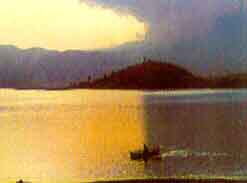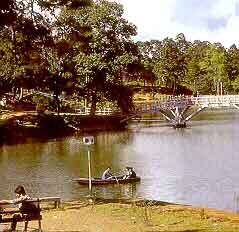| Destinations
|
|||
Meghalaya is a small state sandwiched between Assam and Bangladesh. It has an area of 22,429 sq. kms. and is located between 25 degree and 26.15 degree North (Latitude) and 89.45 degree and 92.47 degree East (Longitude). Shillong 17 kms. before Shillong is Umiam, also known as Barapani where a large lake was formed after a hydro-electric dam was built across a stream. In recent years, this has become an increasingly popular place for outings and weekend visits. The Orchid Lake Resort, designed by the famous architect Charles Correa, and constructed amongst pine wood overlooks the lake. Flurries of rain often sweep across the water body, scattering visitors, and splash loudly on the large bay windows of the lounge. There are facilities for water sports here: from kayaking and water skiing for the adventurous to water cycling and simple boating for the less brave. The Orchid Lake Resort, run by the Meghalaya Tourism Department, has pleasantly-appointed rooms with balconies, a restaurant and bar. |
More on North East • Arunachal Pradesh • Manipur • Meghalaya • Mizoram • Nagaland • Tripura
More about Assam
Travelogues |
||
 Shillong became Assam's capital in 1874 and remained so for a century until the seat of government in Assam went to the plains and Meghalaya was established as a separate state. The city derives its name from the deity Shillong or Lei Shillong, which is worshipped at the Shillong Peak, 10 kms. from the main town and 1,965 metres above sea level. This is the highest point in the state and commands a panoramic view of the Shillong valley. In the evening, the city lights below glitter and twinkle like a giant Christmas tree.
Shillong became Assam's capital in 1874 and remained so for a century until the seat of government in Assam went to the plains and Meghalaya was established as a separate state. The city derives its name from the deity Shillong or Lei Shillong, which is worshipped at the Shillong Peak, 10 kms. from the main town and 1,965 metres above sea level. This is the highest point in the state and commands a panoramic view of the Shillong valley. In the evening, the city lights below glitter and twinkle like a giant Christmas tree.
One of the first places that a newcomer to Shillong should visit is the lewduh Bazar, earlier known as the Bara Bazar. Cheerful women dominate this market, the largest of its kind in the entire North East. Oranges, pineapples and other fruits; vegetables, meat and fish are on sale here as are consumer durables. The prominent role of women is highly visible in the Khasi Hills, where the Khasis, a community which is said to have its origins in Kampuchea, South East Asia, and speaks a language that has its roots in Mon-Khmer, follow a matrilineal society. Under this custom, the children take the name of their mother and the youngest daughter becomes the custodian of family property. Other sites to visit are the Ward's Lake, for a leisurely stroll or boating. You can feed the carp from the wooden bridge. The Botanical Garden, a secluded park, borders the lake and further down the hill is the celebrated Golf Course, called the Gleneagles of the East. The Golf Club retains a colonial touch and the area, as are other parts of the city, is good for long walks. In fact, because of the density of road traffic and frequent traffic jams, walking is recommended as an easy way of seeing many parts of the heart of Shillong.
Of all the falls in and around Shillong, among the prettiest is the Sweet Falls near Happy Valley. A gushing stream of water plunges into a deep, cool and inviting pool. It's a good hike down to the stream and a nice way to spend a day. Then there are the Bishop and Beadon Falls and the Elephant Falls which draw many tourists. The Elephant Falls is 12 kms. On the outskirts of the city and near Shillong Peak. If there is time, visitors should travel to Sohpetbneng Peak, 20 kms. from Shillong, set amid a beautiful view and the backdrop of a sacred forest. Excursions
A 56 kms. drive along a narrow winding road takes you to Cherrapunjee, one o f the wettest places in the world. Indeed, this town, now known as Sohra, and the village of Mawsynram, on a neighbouring hill, have competed with each other for the record of the wettest place on earth. For weeks, there is no let up from the pounding of the rain on tin roofs. But waterfalls leap and roar from the edge of the road into deep gorges below, including the famed Nohsngithiang Falls. On a fog-shrouded day, however, you can hear the waterfall and yet not see it. This lovely town is also famous for its limetsone caves and orange honey. A centre of Khasi culture and literature, it also has the oldest Presbyterian Church. The Ramakrishna Mission, which has been actively in spreading literacy in the region, has a large centre here. A bit further down the road to limestone caves, one can stop by a graveyard where British missionaries and their close relatives lie buried. Before reaching the caves, visitors are awed by a series of giant pillars or megaliths that have been erected near a stream. Such megaliths are to be seen in different parts of the Khasi and Jaintia Hills and are usually erected to commemorate great deeds or to honour dead chieftains. Visitors can stay at the Circuit House or return to Shillong where they can stay at the government-run Pinewood Hotel or in numerous private hotels.
Enroute to Nartiang, 64 kms. from Shillong, is the small but pretty lake of Thadlaskein, good for picnics. The gently rolling meadows around the lake are an invitation to relax. This lake, according to legend, was dug by the ends of bows by members of 290 clans of a rebel general of a Jaintia Raja. 64 kms. from Shillong is Jakrem, a popular health resort having hot-springs of sulphur water, believed to have curative medicinal properties. Dawki, a border town, 96 kms. from Shillong gives you a glimpse of Bangladesh. The colourful annual boat race during spring at the Umgot river is an added attraction. 140 kms. from Shillong, is Ranikor, a scenic spot and an angler's paradise because of a huge population of carp and mahseers. |
|||
Editor: Romola Butalia (c) India Travelogue. All rights reserved. |
|||

 Shillong is full of churches and waterfalls. The most beautiful churches is the Cathedral of Mary Help of Christians, located on a hill; stained glass windows and high arches add to the beauty of this building. Directly below, carved out of 1 the hill, is the Grotto Church. The All-Saints Church opposite the State Central Library is another attractive building of wood and plaster. The State Central Library has a wealth of that can be a book lover's delight. A museum there gives glimpses of the region's heritage. Pop and rock concerts are often held here and are extremely popular, with songs in Khasi and English. The Butterfly Museum that had begun breeding butterflies as a conservation measure and for their commercial value has a good display of mounted butterflies and beetles from India and abroad. Nearby is the Lady Hydari Park, which has a mini-zoo, a children's section and well-laid out flower beds.
Shillong is full of churches and waterfalls. The most beautiful churches is the Cathedral of Mary Help of Christians, located on a hill; stained glass windows and high arches add to the beauty of this building. Directly below, carved out of 1 the hill, is the Grotto Church. The All-Saints Church opposite the State Central Library is another attractive building of wood and plaster. The State Central Library has a wealth of that can be a book lover's delight. A museum there gives glimpses of the region's heritage. Pop and rock concerts are often held here and are extremely popular, with songs in Khasi and English. The Butterfly Museum that had begun breeding butterflies as a conservation measure and for their commercial value has a good display of mounted butterflies and beetles from India and abroad. Nearby is the Lady Hydari Park, which has a mini-zoo, a children's section and well-laid out flower beds.
 The summer capital of the Jaintia kings, Nartiang is about 65 kms. east of Shillong. The Jaintias are one of the three main tribes which inhabit Meghalaya: the others being the Khasis and the Garos. Nartiang's greatest attraction is to be found off the small road that runs amid forest, streams and hills in a quiet and shaded glen. A short walk and you will find yourself in the playground of giants, it appears: huge stone slabs are positioned erect or flat or sloping. But this is more than what meets the eye: it is a park of megaliths, some of which, are said to have been placed there by a giant called U Mar Phalyngki. The tallest is 8 mtrs. high and 2 mtrs. wide. Megalithic cultures have existed across the world, including the one at Stonehenge in England. A 500 year old Temple of Durga is another attraction at Nartiang.
The summer capital of the Jaintia kings, Nartiang is about 65 kms. east of Shillong. The Jaintias are one of the three main tribes which inhabit Meghalaya: the others being the Khasis and the Garos. Nartiang's greatest attraction is to be found off the small road that runs amid forest, streams and hills in a quiet and shaded glen. A short walk and you will find yourself in the playground of giants, it appears: huge stone slabs are positioned erect or flat or sloping. But this is more than what meets the eye: it is a park of megaliths, some of which, are said to have been placed there by a giant called U Mar Phalyngki. The tallest is 8 mtrs. high and 2 mtrs. wide. Megalithic cultures have existed across the world, including the one at Stonehenge in England. A 500 year old Temple of Durga is another attraction at Nartiang.